Ageing and sexing details:
|
JAN - JUL: after-hatch-year
male |
Male Common Grackles have glossy plumage over most of their body, but especially so on the head, which often has a purple sheen. Note the especially hefty bill on males. Age can generally not be determined without examining the underwing.

Photo by Marcel Gahbauer,
McGill Bird Observatory (QC), May 2006
The open upper wing of a male Common Gracklee shows some of the glossy plumage present across the body, especially on the greater coverts. The second photo shows the underwing covert pattern typical of male after-hatch-year grackles, with a contrast between adjacent tracts, but no moult limits within any of them.

Photo by Marie-Anne Hudson, McGill Bird Observatory (QC), May 2008

Photo by Marie-Anne Hudson, McGill Bird Observatory (QC), May 2008
Male grackles tend to have visibly longer tails than females, but they rarely provide any information about age.
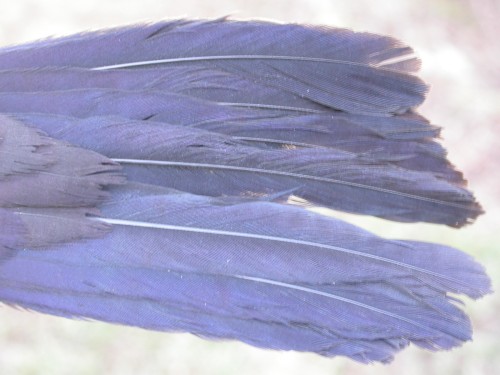
Photo by Marcel Gahbauer,
McGill Bird Observatory (QC), May 2006
RETURN TO AGE/SEX
OVERVIEW
|
JAN - JUL: after-hatch-year
female |
Female Common Grackles have the same overall pattern of plumage as males, but it is much less glossy, and the head tends to be mostly bluish, with the purple sheen of males generally absent.
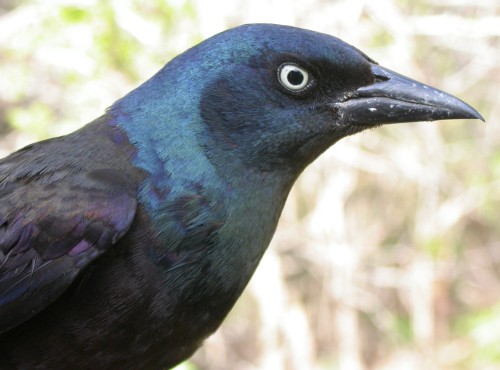
Photo by Marcel Gahbauer,
McGill Bird Observatory (QC), May 2006
The wing of AHY females is relatively uniform, with some colour on the greater coverts, but usually less so than on males. The pattern in the underwing coverts is the same as on males, though the contrast between the lightest and darkest feathers is not as great.
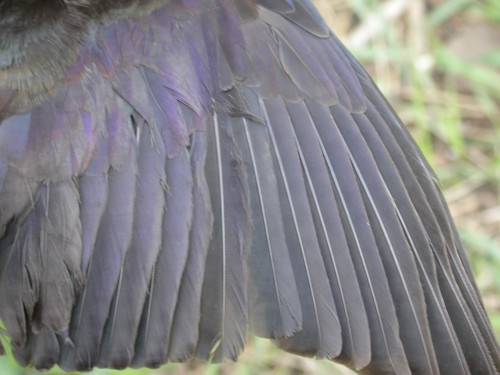
Photo by Marcel Gahbauer,
McGill Bird Observatory (QC), May 2006
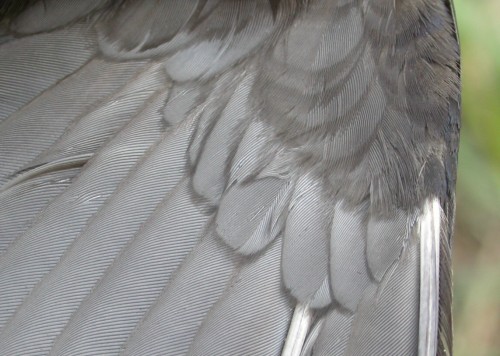
Photo by Marcel Gahbauer,
McGill Bird Observatory (QC), May 2006
Female grackles generally have a somewhat shorter tail than males, but it usually provides no information about age.
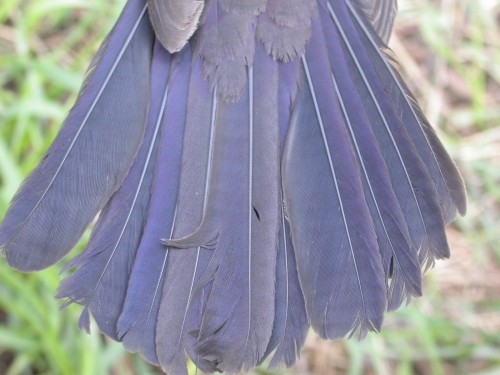
Photo by Marcel Gahbauer,
McGill Bird Observatory (QC), May 2006
RETURN TO AGE/SEX
OVERVIEW
|
JAN - JUL: second-year
male |
Second-year males typically appear identical to older males, except for the underwing coverts and occasionally a couple of other retained feathers that are best seen on an open wing.
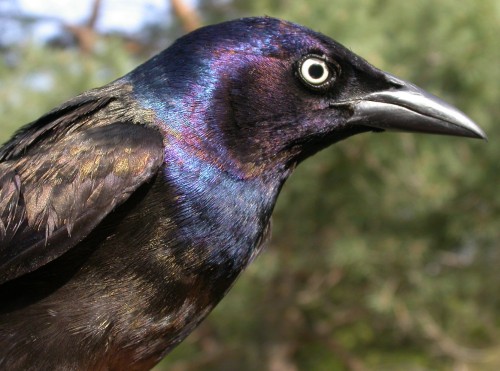
Photo by Marcel Gahbauer,
McGill Bird Observatory (QC), May 2006
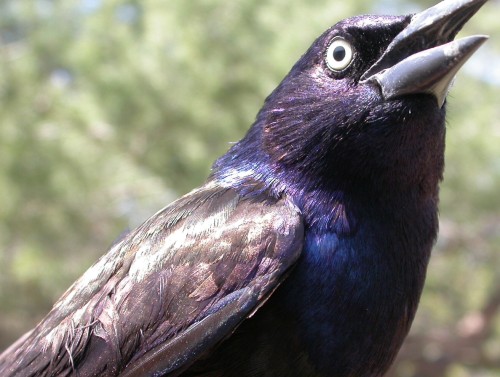
Photo by Marcel Gahbauer,
McGill Bird Observatory (QC), May 2005
The upper wing usually provides little information about ageing, although occasionally one or two juvenile secondaries may be retained, recognizable by their pale brown colour contrasting with the adjacent blackish feathers. More frequently, second-year grackles can be recognized by moult limits within tracts of the underwing coverts, as in the second and third photos below.
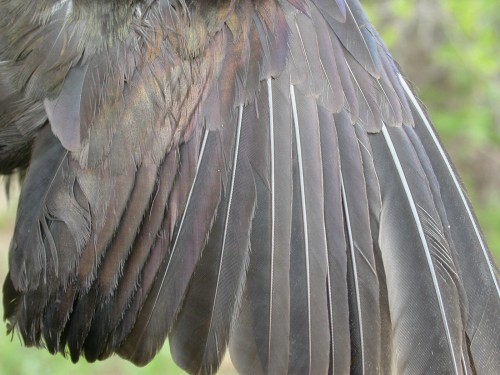
Photo by Marcel Gahbauer,
McGill Bird Observatory (QC), May 2006
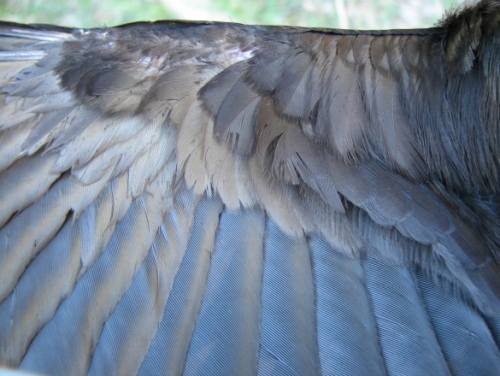
Photo by Marie-Anne Hudson, McGill Bird Observatory (QC), May 2008
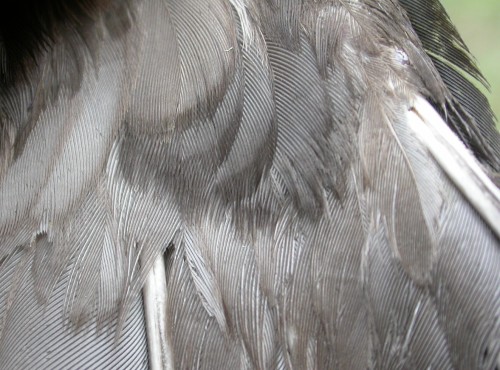
Photo by Marcel Gahbauer,
McGill Bird Observatory (QC), May 2006
The tail generally provides no useful information about the age of grackles.
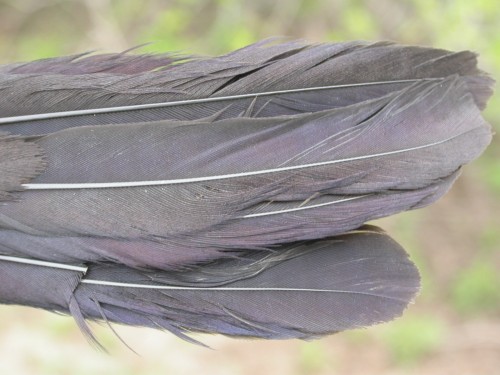
Photo by Marcel Gahbauer,
McGill Bird Observatory (QC), May 2006
RETURN TO AGE/SEX
OVERVIEW
|
JAN - JUL: second-year
female |
Second-year female Common Grackles are not reliably separable from older females, but it seems that some are particularly dull in plumage, as in the photo below.
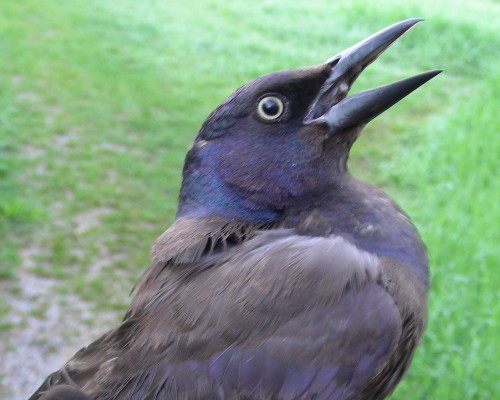
Photo by Marie-Anne Hudson, McGill Bird Observatory (QC), May 2008
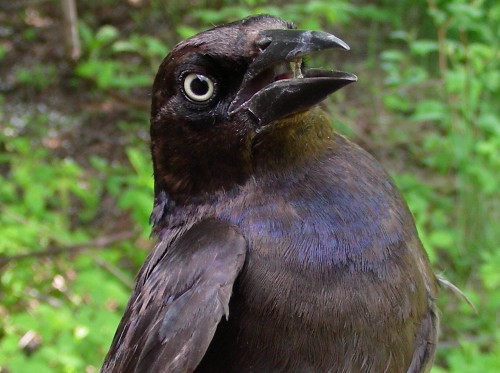
Photo by Marie-Anne Hudson, McGill Bird Observatory (QC), May 2008
In most cases age is best determined by looking at the underwing, but occasionally (as in the second photo below), there are retained brownish juvenile secondaries that contast visibly with the adjacent adult flight feathers, and these are sufficient to identify a grackle as second-year. As with males, moult limits within the underwing covert tracts also indicate the age as second-year.
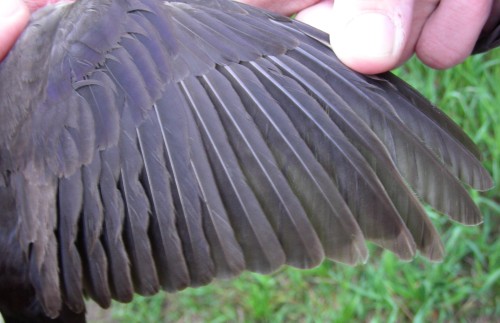
Photo by Marie-Anne Hudson, McGill Bird Observatory (QC), May 2008
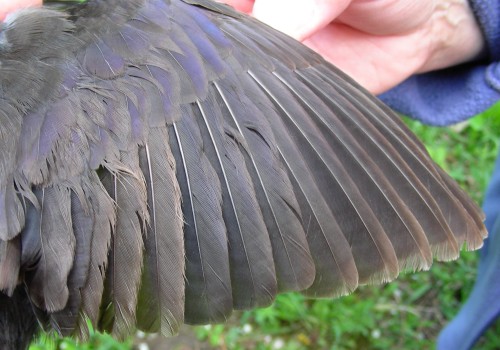
Photo by Marie-Anne Hudson, McGill Bird Observatory (QC), May 2008
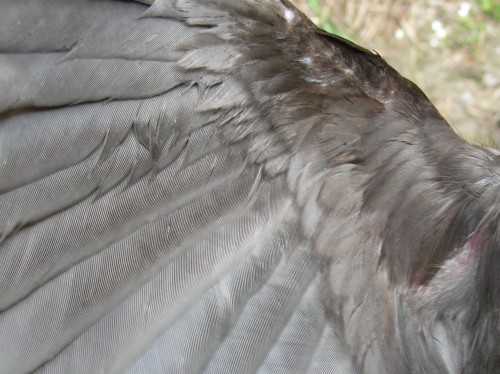
Photo by Marie-Anne Hudson, McGill Bird Observatory (QC), May 2008
The tail usually provides no useful information for ageing grackles.
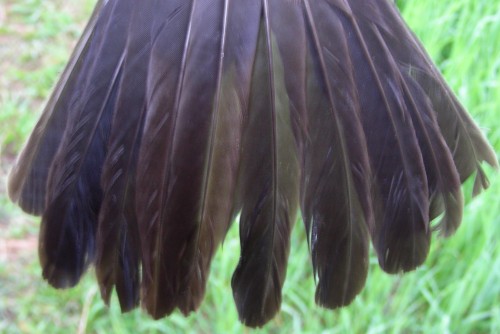
Photo by Marie-Anne Hudson, McGill Bird Observatory (QC), May 2008
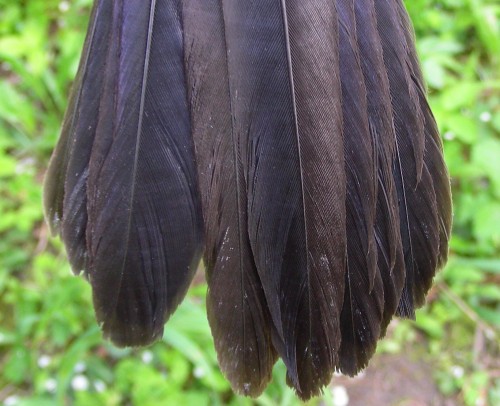
Photo by Marie-Anne Hudson, McGill Bird Observatory (QC), May 2008
RETURN TO AGE/SEX
OVERVIEW
|
JUN - DEC: after-hatch-year
male |
As in spring, the largest and glossiest Common Grackles are after-hatch-year males. However, if observed during their body moult, some may have a scruffy appearance with some patches of brown, as in the photo below.
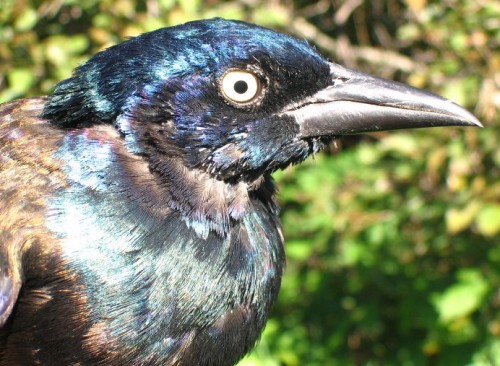
Photo by Seabrooke Leckie,
McGill Bird Observatory (QC), September 2006
The glossiness of the flight feathers in the photo below is somewhat exaggerated by being taken in the sun, but nonetheless reflects the typical pattern of plumage. There are no moult limits within the tracts of underwing coverts.
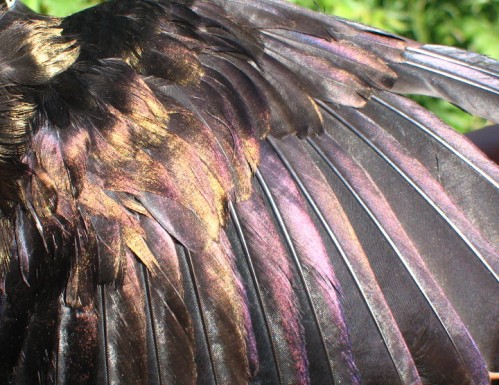
Photo by Seabrooke Leckie,
McGill Bird Observatory (QC), September 2006
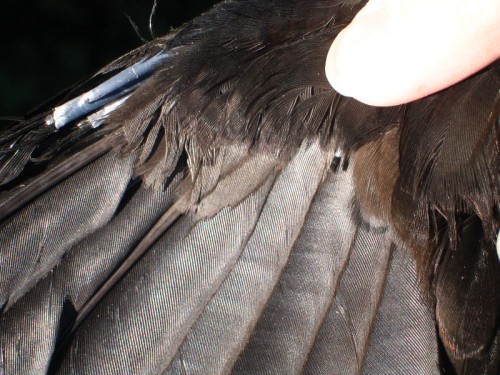
Photo by Seabrooke Leckie,
McGill Bird Observatory (QC), September 2006
RETURN TO AGE/SEX
OVERVIEW
|
JUN - DEC: after-hatch-year
female |
As in spring, females are duller than males, with a bluish head and dark relatively dull body. However, if observed during their body moult, some may have a scruffy appearance with some patches of brown.
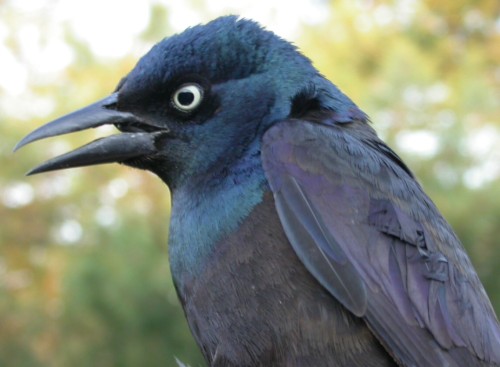
Photo by Marcel Gahbauer,
McGill Bird Observatory (QC), October 2004
The wing below is in active moult, with the outer primaries and secondaries being replaced.
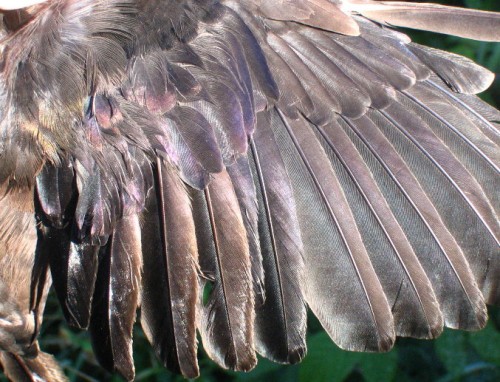
Photo by Seabrooke Leckie,
McGill Bird Observatory (QC), September 2006
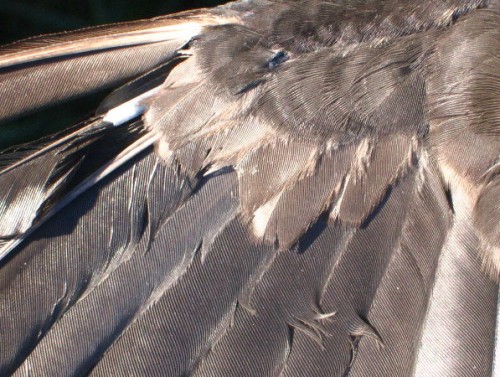
Photo by Seabrooke Leckie,
McGill Bird Observatory (QC), September 2006
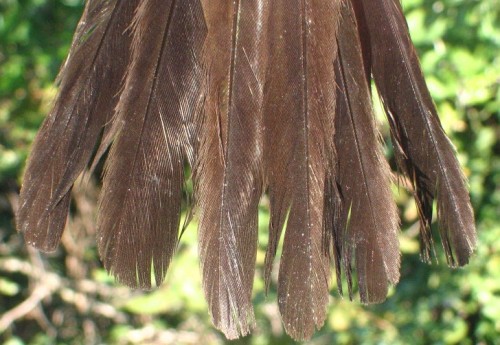
Photo by Seabrooke Leckie,
McGill Bird Observatory (QC), September 2006
RETURN TO AGE/SEX
OVERVIEW
|
JUN - DEC: hatch-year
male |
Hatch-year males may have a variable amount of brown in the plumage depending on the timing of moult. The first photo below is a of an individual fairly advanced in its moult, with a mostly glossy head, while in the second case a side profile reveals that wing moult has commenced, but the head remains entirely brown.
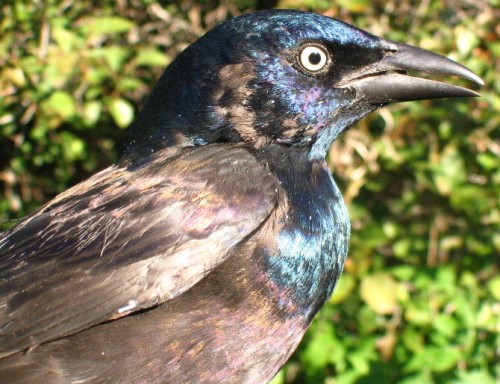
Photo by Seabrooke Leckie,
McGill Bird Observatory (QC), September 2006

Photo by Marie-Anne Hudson, McGill Bird Observatory (QC), August 2008
The two photos below illustrate the variability in appearance of hatch-year male wings. In the first case, the greater coverts and most of the median and lesser coverts have been replaced, as well as the inner primaries and primary coverts, which contrast with the paler brown retained outer feathers. In the second case, almost all the wing feathers have been replaced, except for three secondaries. Later in fall, there are often no juvenile feathers retained at all, and the upper wing looks the same as after-hatch-year males. At that point, the only way to recognize hatch-year birds is by finding moult limits within tracts of underwing coverts, as in the third, fourth, and fifth photos below.
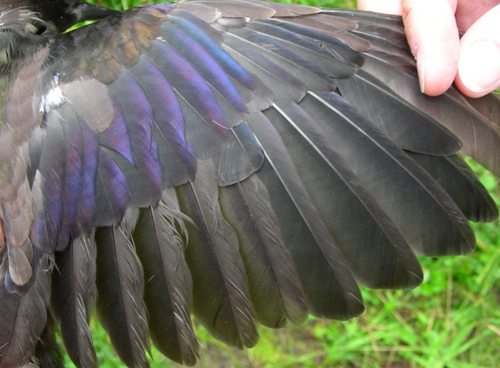
Photo by Marie-Anne Hudson, McGill Bird Observatory (QC), May 2008
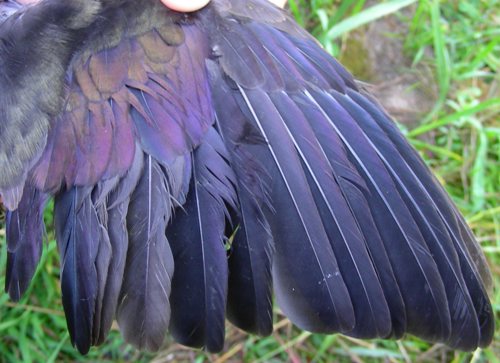
Photo by Marie-Anne Hudson, McGill Bird Observatory (QC), September 2008
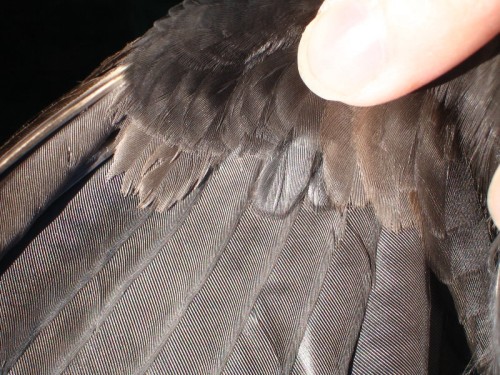
Photo by Seabrooke Leckie,
McGill Bird Observatory (QC), September 2006

Photo by Seabrooke Leckie,
McGill Bird Observatory (QC), September 2006

Photo by Marie-Anne Hudson, McGill Bird Observatory (QC), May 2008
The tail usually provides no useful information about the age of grackles.
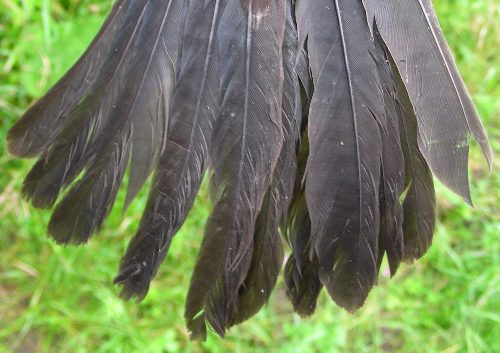
Photo by Marie-Anne Hudson, McGill Bird Observatory (QC), August 2008
RETURN TO AGE/SEX
OVERVIEW
|
JUN - DEC: hatch-year
female |
Hatch-year females may have a variable amount of brown in the plumage, depending on the timing of moult. The first photo below is of an individual that has begun moulting both its body feathers and wing feathers, while the second is less advanced. However, since after-hatch-year birds may also have a mottled apperance during moult, age is best determined by examining the wing.

Photo by Seabrooke Leckie,
McGill Bird Observatory (QC), September 2006
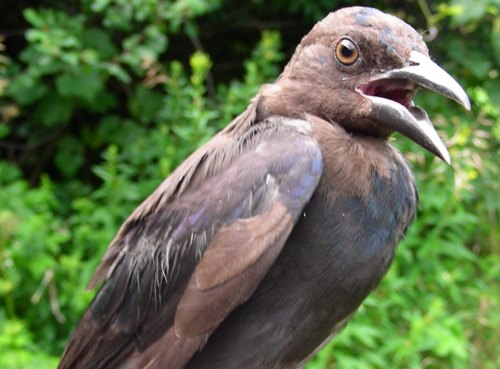
Photo by Marie-Anne Hudson, McGill Bird Observatory (QC), August 2008
Retained brown juvenile feathers on the wing are indicative of hatch-year birds. If present, these most often occur among the outer primaries and primary coverts, alula, inner secondaries, and median coverts, as illustrated by the photos below. In cases where these have all been replaced, check for moult limits among within tracts of the underwing coverts.
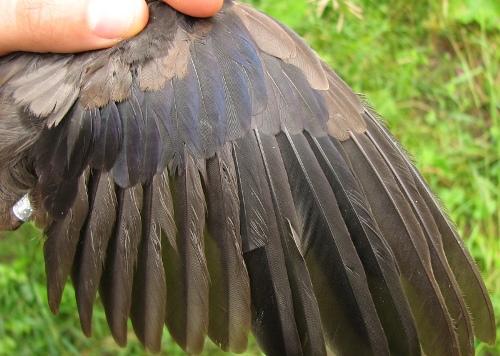
Photo by Marie-Anne Hudson, McGill Bird Observatory (QC), August 2008
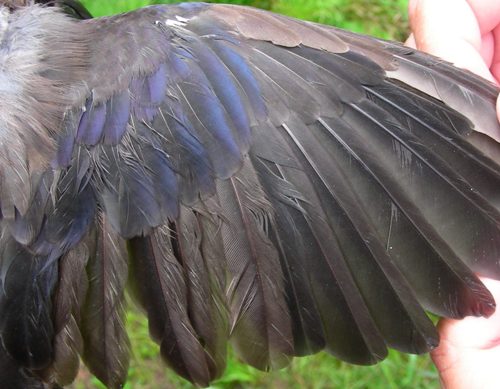
Photo by Marie-Anne Hudson, McGill Bird Observatory (QC), August 2008
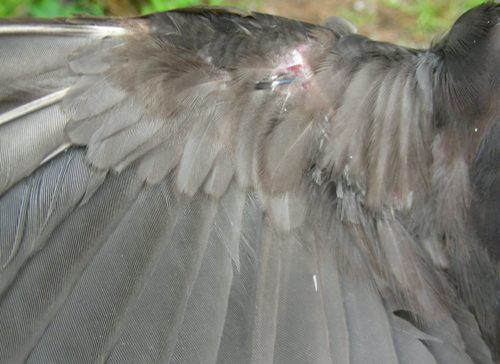
Photo by Marie-Anne Hudson, McGill Bird Observatory (QC), May 2008
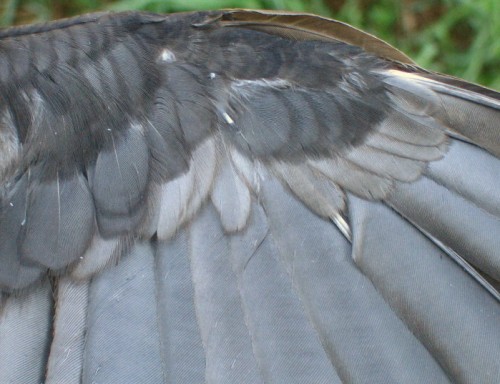
Photo by Seabrooke Leckie,
McGill Bird Observatory (QC), September 2006
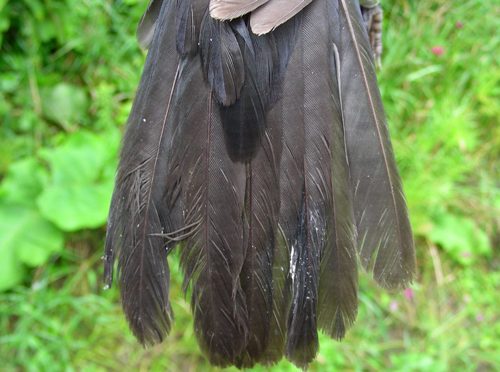
Photo by Marie-Anne Hudson, McGill Bird Observatory (QC), August 2008
|
JUN - SEP: juvenile unknown |
Juvenile Common Grackles are largely brown.
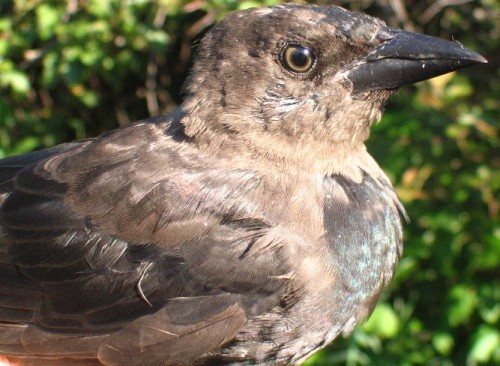
Photo by Seabrooke Leckie,
McGill Bird Observatory (QC), September 2006

Photo by Marie-Anne Hudson, McGill Bird Observatory (QC), May 2008
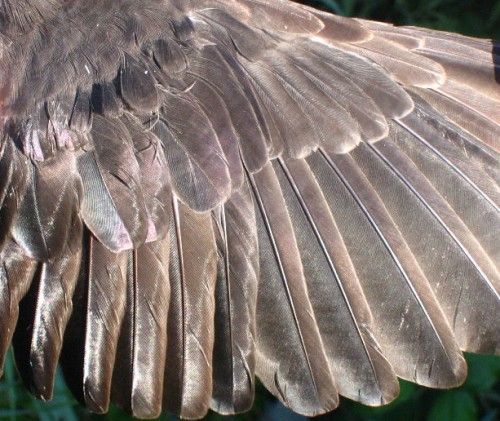
Photo by Seabrooke Leckie,
McGill Bird Observatory (QC), September 2006
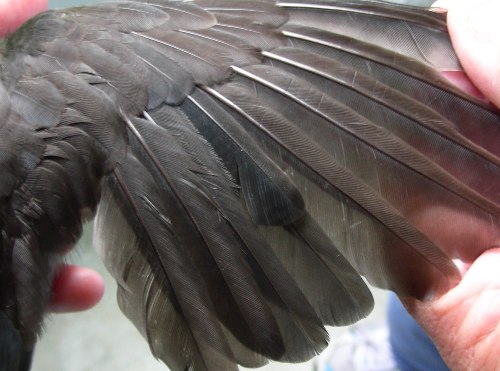
Photo by Marie-Anne Hudson, McGill Bird Observatory (QC), May 2008
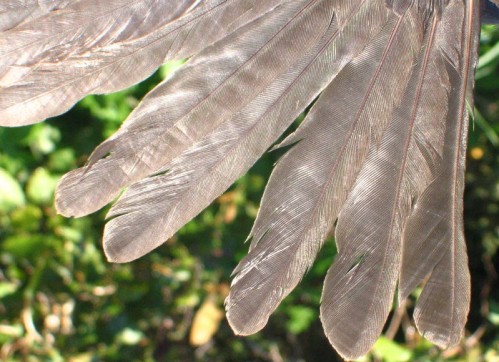
Photo by Seabrooke Leckie,
McGill Bird Observatory (QC), September 2006
RETURN TO AGE/SEX
OVERVIEW